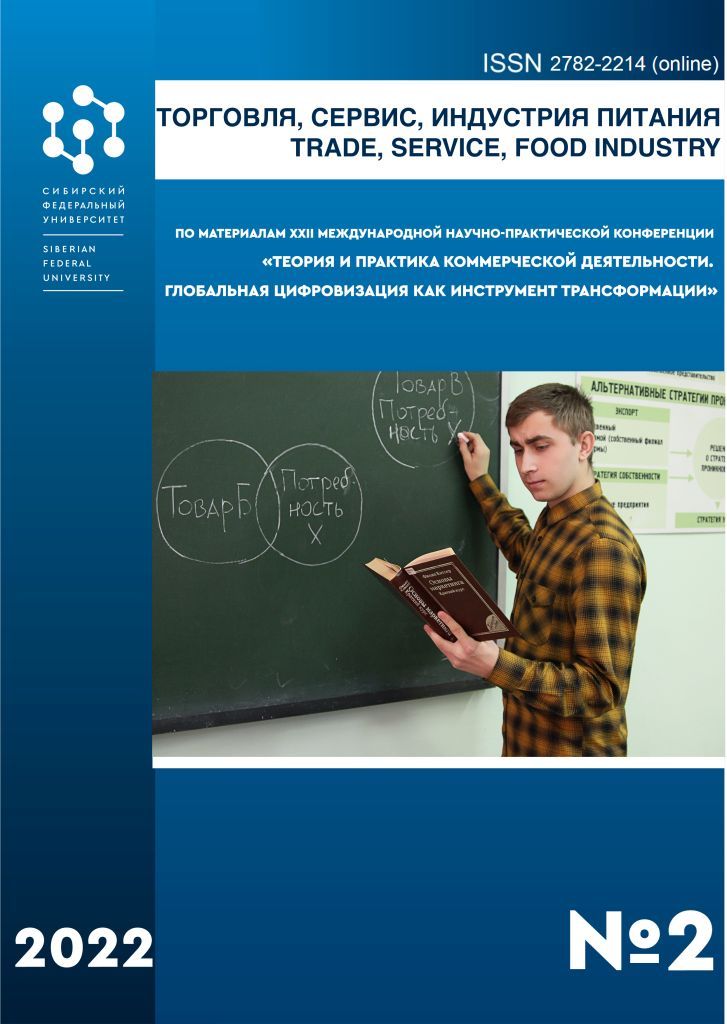For Russian companies, the Chinese market offers vast opportunities to increase the scale of their activities and maximize profits.But when entering the market, companies face a number of problems: the difficulty of gaining consumer confidence, unfamiliarity with China's domestic market, its needs, misunderstanding of differences in the mentality and psychology of consumption. Therefore, the purpose of the study was to identify the main factors in the formation of brand trust among Chinese consumers.The results of the work will be useful for food manufacturing companies seeking to export their products to the Chinese market.
brand trust, cultural characteristics, customersneeds, brand adaptation and positioning, China
1. D'Alessandro, D. F. (2001). Brand Warfare: 10 Rules For Building The Killer Brand. New York: McGraw-Hill, 208.
2. D'Alessandro, D. F. (2003). Career Warfare: 10 Rules For Building A Successful Personal Brand and fighting to keep it. New York: McGraw-Hill, 216.
3. Ambler, T. (2008). To what extent is brand equity driven by trust. Brand management. 4. 212-225.
4. Ambler, T. (1996). Marketing From Advertising to Zen. Harlow, United Kingdom:Financial Times Prentice Hall Hall, 384.
5. Trout, J.&Ries, A. (1981). Positioning: The Battle For Your Mind. New York: McGraw-Hill, 246.
6. Trout, J. &Ries, A. (1990). Bottom-Up Marketing. New York: McGraw-Hill, 240.
7. Trout, J. &Rivkin, S. (2010). Repositioning: Marketing in an Era of Competition, Change, and Crisis. New York: McGraw-Hill, 224.
8. Trout, J. (2004). Jack Trout on Strategy. New York: McGraw-Hill, 144.
9. Gobé, M. (2001). Emotional Branding: The New Paradigm for Connecting Brands to People. New York: Allworth Press, 319.
10. Gobé, M. (2002). Citizen Brand: 10 Commandments for Transforming Brand Culture in a Consumer Democracy. New York: Allworth Press, 256.
11. Gobé, M. (2010). Brandjam: Humanizing Brands Through Emotional Design. New York: Allworth Press, 364.
12. Starchukova, K.D. Consumer preferences of Chinese residents to Russian food products / K.D. Starchukova, T.D. Lykova // IV International Scientific and Practical Conference “CROSS-BORDER MARKETS OF GOODS AND SERVICES: RESEARCH PROBLEMS”. Vladivostok, 2021. [Electronic resource]. URL: https://www.dvfu.ru/upload/medialibrary/db8/cxmgnotr2lhgl5wt3ff0wemkvn33esob/Transgranichnyerynkitovaroviuslugproblemyissledovaniya_2021.pdf (date of request 12.03.2022).
13. Food Safety Law of the People's Republic of China, February 28, 2009 [Electronic resource]. URL: https://fsvps.gov.ru/fsvps-docs/ru/importExport/china/files/zakon1.pdf
14. “Law of the People's Republic of China on Import Inspection” dated February 21, 1989.[Electronic resource]. URL: https://fsvps.gov.ru/fsvps-docs/ru/importExport/china/files/law_china_grain_31072018.pdf
15. 中国国家统计普查数据 Data from the National Statistical Census of China [Electronic resource]. URL: http://www.stats.gov.cn/tjsj/pcsj/
16. 中华人民共和国进出口关税条例 Regulation of import and export tariffs of the People's Republic of China [Electronic resource]. URL: https://zhuanlan.zhihu.com/p/302439065
17. Shen Yanru. (2012). 奥利奥品牌中国市场营销策略研究 - Research on Marketing Strategy of Oreo Brand in China. [Electronic source] URL:https://wenku.baidu.com/view/ba1dd3597cd5360cba1aa8114431b90d6c8589b4.html (Date of access: 01.03.2022).
18. Chen Qi. (2012). 雀巢公司在中国的营销策略研究 - Research on Nestlé's Marketing Strategy in China. [Electronic source] URL:https://www.docin.com/p-2840633265.html (Date of access: 01.03.2022).
19. Li Tingyu, Liu Huan, Xiang Qin, Liu Jinzhou, Zhao Honggang, GuoQinghe, Yang Yunfeng. (2012). 达利园营销策划总结 - Dali Garden Marketing Planning Summary. [Electronic source] URL: https://wenku.baidu.com/view/2c2f70c449fe04a1b0717fd5360cba1aa8118cdd.html (Date of access: 01.03.2022).
20. JinXuecheng. (2010). 好丽友公司在华营销策略研究基于情感因素 - Research on Orion's Marketing Strategy in China-Based on Emotional Factors. [Electronic source] URL: https://xueshu.baidu.com/usercenter/paper/show?paperid=d528944ab1170fab6fb8d1ef00e67234&site=xueshu_se (Date of access: 01.03.2022).
21. Chiara Menaspà. (2012). 费列罗在中国巧克力市场的定位 - Ferrero's positioning in the Chinese chocolate market. [Electronic source] URL: https://wap.cnki.net/lunwen-1012338177.html (Date of access: 01.03.2022).
22. GarloGambirasio. (2011). 费列罗集团在中国的市场策略 - Ferrero Group's Market Strategy in China. [Electronic source] URL: https://xueshu.baidu.com/usercenter/paper/show?paperid=4d9ce1d9079f1e09320feea331cd2c4e&site=xueshu_se (Date of access: 01.03.2022).
23. Ma Juanling. (2015). 稻香村市场营销的策划书 - Daoxiang Village's marketing plan. [Electronic source] URL: https://max.book118.com/html/2018/1122/8030024022001134.shtm (Date of access: 01.03.2022).
24. Chen Jiachuang, Wu Xuan. (2020). 苏州稻香村市场营销策略研究 - Research on Marketing Strategy of Suzhou Daoxiang Village. [Electronic source] URL: https://www.cnki.com.cn/Article/CJFDTotal-YXJI202020025.htm (Date of access: 01.03.2022).








